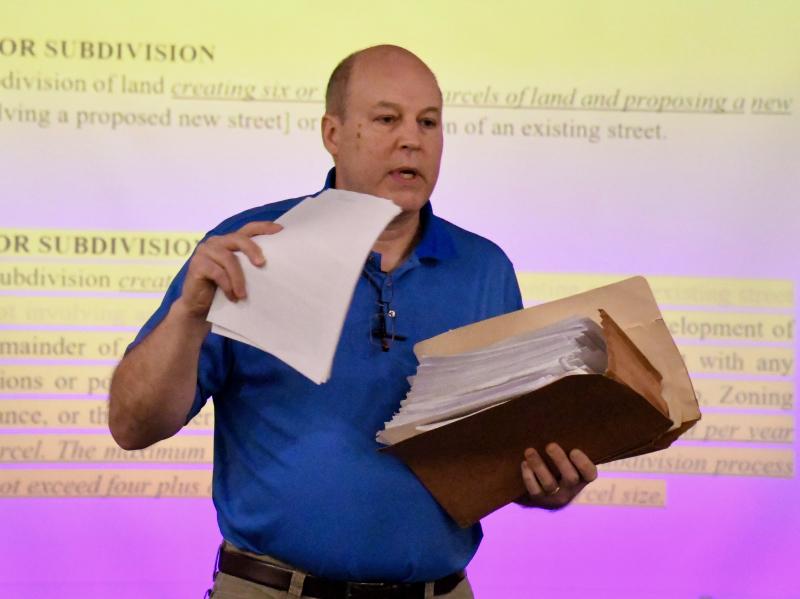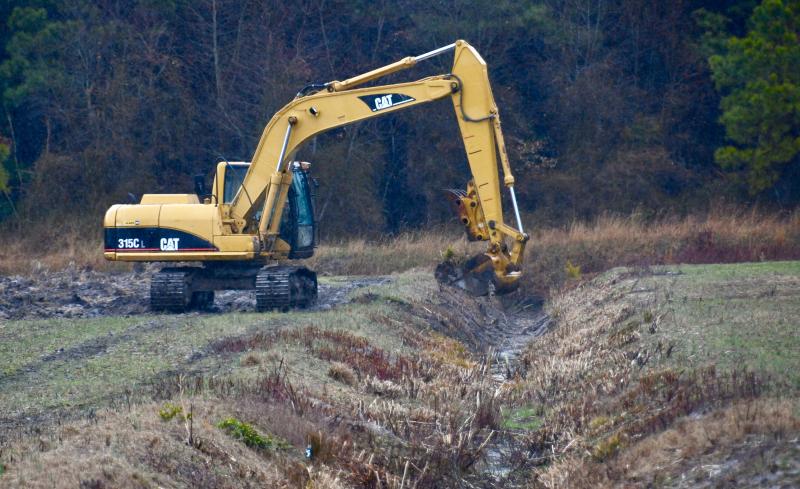Sussex wetland buffers group still at odds over final draft
After more than a year of meetings, a Sussex County Council-appointed wetland buffers committee still does not have an updated ordinance to present to county officials. And the COVID-19 health crisis has delayed further action for the foreseeable future.
During a March 4 meeting, group members were given another draft ordinance. “We have some updates based on your feedback. It represents a lot of tweaks you wanted addressed,” said Sussex County Administrator Todd Lawson.
But as it turned out, the most recent version met with some of the same debate as previous versions. Some group members were so disappointed with a new section relating to selective cutting in buffers, they wanted it totally revamped or removed from the proposed ordinance.
Lawson said the group should be proud how it has addressed new regulations for buffers, but he admitted that consensus on several other issues, including drainage, has not been achieved.
While Lawson called drainage the elephant in the room, several members agreed it would be beneficial to address drainage issues in a different ordinance.
“This is month 13, and I thought we were close to consensus; at least 95 percent there. Since then, a couple more topics have been brought in,” said RK&K consultant Jim Eisenhardt.
“I don't want another nine months of meetings. I don't even want another meeting,” said committee member Jay Baxter, a Georgetown-area farmer.
Provide another draft
Lawson said the goal is to get consensus for an ordinance to solicit comments from others. He said a public workshop with the committee, planning and zoning commission, and county council will take place before public hearings are scheduled. “But we are not ready today for a workshop. We have a little more work to do,” he said. “We are at the fine-tuning stage.”
Lawson said county staff would take a shot at another draft based on comments during the meeting. “We have to go to council with something soon,” he said.
Protecting woodlands
There appears to be consensus that wooded areas in buffers or around water resources should to be protected. How to provide and enforce that protection is still up in the air.
Currently, county code does not prevent developers from clear-cutting woods down to the waterline.
Environmental resource consultant Ed Launay said he was concerned unintended consequences in the proposed ordinance would not address that issue.
He said he fears developers or property owners would clear-cut sites in advance of filing land-use applications with the county; he's aware of projects already being prepared using this approach.
Launay said incentives should be in the ordinance aimed at retaining existing forests or replacing forests. A possible incentive for maintaining wooded areas could be a reduction in the width of a tidal buffer from the proposed 100 feet to 75 feet, he said.
Others on the committee say even with proposed increased buffers, buffers are still at a minimum, and they do not support a reduction in width.
“There need to be incentives to keep forest on a site,” Eisenhardt agreed.
Lawson said staff would take another look at incentives, which the group has debated several times. He said staff may provide a list to council, and let them decide which incentives they support.
Access for maintenance
Access to water resources for future maintenance, to ensure streams are not blocked and to remove blockages, is another stumbling block.
In the proposed ordinance, if a development includes a perennial or intermittent stream, the adjacent resource buffer management and maintenance plan would allow for perpetual channel maintenance including removal of tree blockages and debris jams, and similar impediments to drainage.
Site plans would include preferred access points and corridors with at least one access point connecting to an existing or proposed road.
Eisenhardt said that section of the ordinance would not impact tidal or nontidal waters or wetlands.
County assistant attorney Vince Robertson said a work crew can't get to a resource area if houses are in the way. “We need a preserved access area through the buffer to the resource,” he said. “It's an issue now.”
But some members say it's unreasonable to expect a developer to provide access for a future issue that may or may not occur.
Eisenhardt said when a developer turns over a subdivision to an HOA, there needs to be access recorded on a site plan. “And there needs to be more than one access point,” he said.
“We don't address impairments to drainage in code today,” said Sussex County engineer Hans Medlarz. “We pretend we don't have a problem, and we would be compounding it by putting a buffer on top of it.”
Selective cutting in buffers
Some committee members took exception to a new section on selective cutting, which is defined as the manual removal of individual trees and shrubs or limbing of trees in a buffer to maintain drainage of streams.
They said they didn't understand a provision that cutting “shall not alter the canopy extent of the resource by impacting an area more than 30 feet wide or one-third the width of the resource buffer, whichever is less.”
Members Rich Borrasso, representing Sussex Alliance for Responsible Growth, and Launay said they had no idea what the provision means. “If we don't understand it, how will the public understand it?” Borrasso asked.
The section includes a list of accepted forest management activities, including removal of trees and vegetation, and the allowable sizes of trees that can be cut or trimmed.
Selective cutting allows for maintenance of native forest; passive community access through buffers; removal of nonnative or nuisance species; removal of tree hazards; and access, only when needed, of a maximum of 30 feet for drainage maintenance and/or access to resources.
“Forest management is not the scope of this group,” said Danielle Swallow, Coastal and Estuarine Research Consulting and University of Delaware staff.
“Because there are forests in buffers, it's a natural and logical consequence,” Medlarz said.
The paragraph that created the most debate in the section involved the filing of a selective-cutting plan with required work done under the guidance of a licensed professional.
Members wanted to know who the plan would be presented to and whether a plan would be required every time a tree in a buffer was cut down or trimmed.
County staff said that's not the intent of the ordinance. “We don't want to a see a plan to cut a tree down,” Robertson said.
What types of buffers?
Seaford-area farmer R.C. Willin said the group seems to support forested buffers as the preferred buffers in the ordinance. “Science does not support that. One type of buffer is not wise,” he said.
Willin has been a proponent of meadow-type buffers, which provide animal habitat and also allow easier access for maintenance.
Willin said quality-of-life issues in subdivisions need to be addressed, as well as financial consequences of the ordinance.
He said critical loose ends are left out of the ordinance that may lead to county council denying it.
“We have a difference of opinion on the value of a forested versus a meadow buffer,” said Delaware Center for the Inland Bays Executive Director Chris Bason.
Bason said a forested buffer is a better choice and easier for an HOA to maintain.
Bason said he needs more time to study the new draft, especially the section on resource and buffer management and maintenance, and the section on enhancement of perennial and intermittent streams' conveyance capacity. “There should be a minimal amount of code,” he said.
Robertson said staff can remove any sections the committee deems unnecessary.
Buffer widths remain the same
Buffer widths have not changed over the past few months. The following buffers are proposed: 100 feet from tidal waters and wetlands; 50 feet from perennial nontidal rivers and streams; and 30 feet from nontidal wetlands and intermittent streams.
Buffers are divided into a 50-foot Zone A, most critical area adjacent to a resource, and a B zone with a list of permitted and not-permitted activities. Sewage facilities, hazardous waste storage, industrial sites, landfills and junkyards, community amenities and all nonwater-related improvements are not permitted in either zone.
Some walking trails, and dry and wet stormwater management ponds, are not permitted in Zone A.




















































